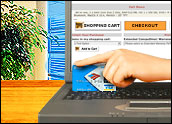
Given the powerful double-digit growth of e-commerce during the first decade of the industry, few merchants worried that a payment alternative to credit cards or the well-established PayPal was needed.
More recently, however, as e-commerce growth rates slow, the fast-growing, credit card-free alternative Bill Me Later has proven that merchants and consumers alike are hungry for alternatives.
Though it has focused mainly on the largest online merchants, Bill Me Later has seen rapid growth. Twenty-two percent of online buyers used Bill Me Later to make a purchase during the holiday shopping season, according to the Piper Jaffray eCommerce Survey for the fourth quarter of 2007.
‘A Frictionless Payment Method’
“We knew there was a pain point for merchants around credit card fees,” Bill Me Later Vice President of Corporate Development Mark Lavelle told the E-Commerce Times. “We also knew that consumers don’t necessarily always want to use credit cards to make purchases.”
In fact, as much as 40 percent of brick-and-mortar sales come from sources other than credit cards, he noted. “We knew there was an opportunity to create a frictionless payment method, which is what e-commerce is all about. You have these catalogs all in one place and sites optimized for user experience and then you get to the checkout and the process grinds to a halt while you reach for your credit card and enter all that data.”
Of course, there are also many consumers concerned about sharing that data for privacy and security reasons. Those consumers may be among the ones that merchants are most eager to reach as well, as they are the last to embrace shopping online.
A Better Mousetrap
The founders of Bill Me Later came from the bank credit card business and knew that any alternative offering would have to address risk issues. They spent extensive time doing that and building the user experience.
“We spent a lot of time before we went live making sure it was a process that would be frictionless for consumers,” Lavelle said. “We wanted it to be something that is incremental for the merchant” rather than taking sales from other payment methods.
Bill Me Later works by enabling users to provide limited information and to be billed later for purchases they make online. Customers with high credit scores qualify quickly for the service, which is finding traction particularly among older and more affluent shoppers.
Online businesses can capture more purchases from more shoppers if they offer alternatives that don’t require entering a credit card number at checkout, said Gartner analyst Avivah Litan.
“For that customer base that isn’t yet buying online regularly, merchants should promote alternative payments,” she told the E-Commerce Times.
The success of PayPal — which has launched a product called “Pay Later” — and the early traction of Google Checkout suggest consumers are aware of the risks associated with sharing their credit card information widely, Litan added. “It’s a message driven home in the media every day.”
Vote of Confidence
The merchant base was receptive to alternatives, but it still took time to build momentum around the new product, said Lavelle. The company’s strategy involved focusing first on major e-commerce merchants with a slow but steady uptake during 2005 and 2006.
While Bill Me Later has been growing steady for some time, it got a huge boost in its profile late in 2007 when Amazon announced it would offer the payment alternative and would also make an investment in the firm, whose parent company is I4 Commerce.
That move “validated Bill Me Later’s place in the payments marketplace,” said Forrester Research analyst Sucharita Mulpuru.
Amazon may view the investment as a way to combat the rise of PayPal, which is owned by rival eBay, but the fact that such a well-known retailer backed the system will resonate with consumers, Mulpuru told the E-Commerce Times.
Working With Merchants
The value of Bill Me Later is expected to increase over time as it continues to work with merchants on the best ways to promote the alternative, such as by offering terms such as 90-day same-as-cash financing, Lavelle said.
Though 90 percent of its business comes from online merchants, it is offering services to brick-and-mortar stores and believes that multichannel retailers will want to offer the same payment options across their various outlets over time, whether a consumers buys through a call center, online or in a store. “We think we’re at the beginning of a birth of a whole new payment network,” he added.
Still, online is where the sweet spot for Bill Me Later is for now. The company has more demand from small and medium-sized merchants than it could keep up with and is expanding its capacity to serve that market, Lavelle pointed out.
“We think we can help reaccelerate the growth of e-commerce,” he noted. “Choice is a concept that consumers crave and enjoy, and that extends to their payment options as well.”
Bill Me Later is not worried that credit card companies will respond to its rise by lowering their fees or responding in other ways, Lavelle concluded. “Our value proposition is well understood as being broader than price alone. We’re [given] access to that customer the merchant can’t reach with other methods and providing a better consumer experience as well.”














































Social Media
See all Social Media